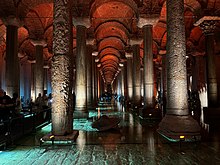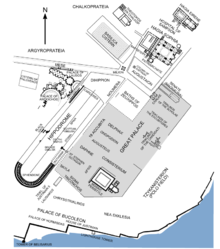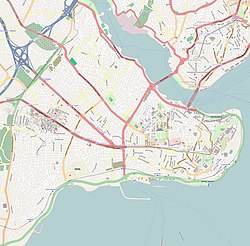Basilica Cistern
This article needs additional citations for verification. (February 2009) |
 Basilica Cistern | |
 | |
| Location | Istanbul |
|---|---|
| Coordinates | 41°0′29″N 28°58′40″E / 41.00806°N 28.97778°E |
| Site notes | |
| Public access | Yes |
| Website | www |

The Basilica Cistern, or Cisterna Basilica (Greek: Βασιλική Κινστέρνα, Turkish: Yerebatan Sarnıcı or Yerebatan Saray, "Subterranean Cistern" or "Subterranean Palace"), is the largest of several hundred ancient cisterns that lie beneath the city of Istanbul, Turkey. The cistern, located 150 metres (490 ft) southwest of the Hagia Sophia on the historical peninsula of Sarayburnu, was built in the 6th century during the reign of Byzantine emperor Justinian I.[1] Today it is kept with little water, for public access inside the space.
History
[edit]This subterranean cistern was called Basilica because it was located under a large public square, the Stoa Basilica, on the First Hill of Constantinople.[2] Prior to its construction, a great basilica stood on the spot. It had been built during the Early Roman Age between the 3rd and 4th centuries as a commercial, legal and artistic centre.[1] The basilica was reconstructed by Illus after a fire in 476.
Ancient texts indicated that the basilica cistern contained gardens surrounded by a colonnade that faced the Hagia Sophia.[1] According to ancient historians, Emperor Constantine built a structure that was later reconstructed and enlarged by Emperor Justinian after the Nika riots of 532, which devastated the city.
Historical texts claim that 7,000 slaves were involved in the construction of the cistern.[1]
The enlarged cistern provided a water filtration system for the Great Palace of Constantinople and other buildings on the First Hill, and continued to provide water to the Topkapı Palace after the Ottoman conquest in 1453 and into modern times.
The existence of the cistern was eventually forgotten by all but the locals who still drew water from it until, in 1565, the French traveller Petrus Gyllius left a record of it. Gyllius recorded being rowed in between the columns and seeing fish swimming in the water beneath the boat.[3]
Features
[edit]This cathedral-size[4] cistern is an underground chamber approximately 138 metres (453 ft) by 65 metres (213 ft)[5] – about 9,800 square metres (105,000 sq ft) in area – capable of holding 80,000 cubic metres (2,800,000 cu ft) of water.[2] The ceiling is supported by a forest of 336[6] marble columns, each 9 metres (30 ft) high, arranged in 12 rows of 28 columns each spaced 5 metres (16 ft) apart. The capitals of the columns are mainly in the Ionic and Corinthian style, with the exception of a few Doric capitals with no engravings. One of the columns is carved with raised pictures of a Hen's Eye, slanted branches, and tears, and resembles the columns of the 4th-century Triumphal Arch of Theodosius I (AD 379–395), erected in the 'Forum Tauri' Square, today's Beyazıt Square. The majority of the columns in the cistern appear to have been recycled from the ruins of older buildings (a process called 'spoliation'), likely brought to Constantinople from various parts of the empire, together with those that were used in the construction of Hagia Sophia. They are carved out of different types of marble and granite.[1]
Fifty-two stone steps descend into the cistern which is surrounded by a firebrick wall with a thickness of 4 metres (13 ft) and coated with a waterproofing mortar. The Basilica Cistern's water came from the Eğrikapı Water Distribution Centre in the Belgrade Forest, which lie 19 kilometres (12 mi) north of the city. It traveled via the 971-metre-long (3,186 ft) Valens (Bozdoğan) Aqueduct, and the original 115-metre-long (377 ft) Mağlova Aqueduct, which was built by the Emperor Justinian.[1]
The weight of the cistern is carried on the columns by means of the cross-shaped vaults and round arches of its roof.
The Basilica Cistern has been restored several times since its original creation. The first repairs were carried out in the 18th century during the reign of the Ottoman sultan Ahmed III in 1723 by the architect Muhammad Ağa of Kayseri. The second major repair was completed during the 19th century reign of Sultan Abdulhamid II (1876–1909). Cracks in the masonry and damaged columns were repaired in 1968, with additional restoration in 1985 by the Istanbul Metropolitan Museum. During the 1985 restoration, 50,000 tons of mud were removed from the cistern, and platforms were erected to replace the boats previously used for touring the cistern. The cistern was opened to the public on 9 September 1987. It underwent additional cleaning In May 1994. Then in 2017 it was once again closed for restoration and earthquake-proofing, reopening to the public in 2022.[7]
Medusa column bases
[edit]
The bases of two columns In the northwest corner of the cistern reuse blocks carved with the face of Medusa.[8] The origin of the two heads is unknown, though it is thought that they were brought to the cistern after being removed from a building of the late Roman period. There is no evidence to suggest that they were previously used as column bases. Tradition has it that the blocks are oriented sideways and inverted in order to negate the power of the Gorgons' gaze.[9]
In popular culture
[edit]The cistern was used as a location for the 1963 James Bond film From Russia with Love.[10] In the film, it is referred to as having been constructed by the Emperor Constantine, with no reference to Justinian, and is fictitiously located under the Soviet consulate. In reality it is a long way away from the former Soviet (now Russian) consulate in Beyoğlu.
The cistern plays a key role in Dorothy Dunnett's historical novel Pawn in Frankincense (1969), fourth volume of The Lymond Chronicles.
In the fantasy series The Old Kingdom, the reservoir beneath the palace in Belisaere was inspired by the cistern.[11]
The finale of the 2009 film The International takes place in a fantasy amalgam of the Old City, depicting the Basilica Cistern as lying beneath the Sultan Ahmed Mosque, which, in the film, is directly adjacent to the Süleymaniye Mosque.[citation needed]
In the 2011 video game, Assassin's Creed: Revelations, the player-controlled character, Ezio Auditore, is given the chance to explore a section of this cistern in a memory sequence entitled The Yerebatan Cistern.[12][13]
The cistern also features in Jean-Baptiste Andrea's film thriller Brotherhood of Tears (2013). In the sequence, the lead character, acting as a transporter (played by Jeremie Renier), delivers a suitcase to a mysterious client (played by Turkish actor Ali Pinar).[14]
The cistern with its inverted Medusa pillar featured in the 2013 Dan Brown novel Inferno[15] (as well as its 2016 film adaptation).[16]
The cistern is featured in Age of Empires IV as one of the two Castle Age Landmarks of the Byzantines, named Cistern of the First Hill
Gallery
[edit]-
Statues in Basilica Cistern
-
Art installation inside Basilica Cistern
-
Columns and vaults of Basilica Cistern
-
Vista showing the reused Roman columns and capitals in the Basilica Cistern
-
Atmospheric lighting now brightens up a visit to the Basilica Cistern
-
Unique "peacock-eyed" column in the Basilica Cistern
See also
[edit]- Cistern of Philoxenos (Istanbul)
- History of Roman and Byzantine domes
- List of Roman cisterns
- Theodosius Cistern (Istanbul)
References
[edit]- ^ a b c d e f "YEREBATAN SARNICI". Archived from the original on 2016-01-04. Retrieved 2016-01-02.
- ^ a b Planet, Lonely. "Basilica Cistern - Lonely Planet".
- ^ Yale 1 Tonguç 2, Pat 1 Saffet Emre 2 (2010). Istanbul The Ultimate Guide (1st ed.). Istanbul: Boyut. pp. 54–56. ISBN 9789752307346.
{{cite book}}: CS1 maint: numeric names: authors list (link) - ^ Zararia, Priti. "Basilica Cistern". The Times of India. ISSN 0971-8257. Retrieved 2024-02-11.
- ^ "The Basilica Cistern". Archived from the original on 2010-12-08. Retrieved 2010-07-15.
- ^ "Yerebatan Palace (Cistern)".
- ^ Sabah, Daily (2022-07-24). "Istanbul's Basilica Cistern reopens after restoration". Daily Sabah. Retrieved 2022-11-23.
- ^ "Exploring the Interior of the Basilica Cistern - 2024". 2024-04-23. Retrieved 2024-05-25.
- ^ "Basilica Cistern Tickets". Retrieved 2023-09-22.
- ^ "James Bond and Karim at Cistern". Spy Movie Navigator. Retrieved 2021-12-18.
- ^ Garth Nix [@garthnix] (November 28, 2022). "While the reservoir under the palace in Belisaere (in my Old Kingdom books) was inspired by Yerebatan Sarnici in Istanbul, I didn't know there was something similar, if more modern, not far away from home in Sydney, now the Tank Gallery of the AGNSW. Might be handy for filming 🤞" (Tweet). Retrieved 2022-12-01 – via Twitter.
- ^ "Memory 6 - The Yerebatan Cistern". IGN. Ziff Davis, LLC. 24 December 2011. Retrieved 30 May 2018.
- ^ Totilo, Stephen (14 September 2011). "See The Real Places You'll Go in the Next Assassin's Creed". Kotaku. Gizmodo Media Group. Retrieved 30 May 2018.
- ^ "La confrérie des larmes". IMDb.
- ^ Guillet, Marc (5 May 2015). "Dan Brown draws visitors Basilica Cistern". Enjoy Istanbul. Retrieved 30 May 2018.
- ^ "Istanbul's Basilica Cistern on silver screen with 'Inferno'". Hurriyet Daily News. Muro Media. 12 October 2016. Retrieved 30 May 2018.
Further reading
[edit]- Crow, J. (2015). "The Water Supply of Byzantine Constantinople". History of Istanbul. Retrieved January 15, 2021.
- Mango, Cyril (1995). "The Water Supply of Constantinople". In Mango, Cyril; Dagron, Gilbert (eds.). Constantinople and its Hinterland. Aldershot, Hampshire, UK: Ashgate Publishing. pp. 9–18. ISBN 9781315259567.
- Ward, K. A.; Crapper, M.; Altuğ, K; Crow, J. (2017). "The Byzantine Cisterns of Constantinople" (PDF). Water Supply. 17 (6). London: IWA Publishing: 1499–1506. doi:10.2166/ws.2017.053.
External links
[edit]- Byzantium 1200 | Basilica Cistern
- Short BBC documentary on the Basilica Cistern [1]








